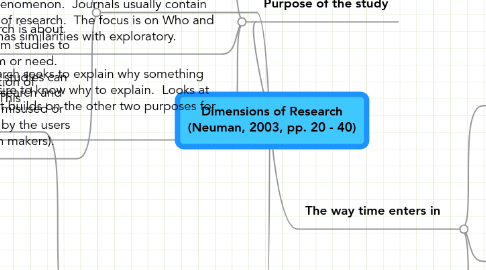
1. How research is used
1.1. Basic (Academic or Pure) Research seeks understanding of the fundamental nature of social reality. It nourishes the expansion of domain knowledge. It is mostly referred to as the kind of research that establishes foundations in the domain.
1.2. Applied Research is about quick, short term studies to solve a problem or need. These kinds of studies can rely on basic research and sometimes are misused or misinterpreted by the users (policy/decision makers).
1.2.1. Kinds of applied research
1.2.1.1. Evaluation
1.2.1.1.1. Formative
1.2.1.1.2. Summative
1.2.1.2. Action
1.2.1.3. Social Impact Assessment
1.2.2. Tools for applied research
1.2.2.1. Needs assessment
1.2.2.2. Cost-benefit anaysis
2. Purpose of the study
2.1. EXPLORATORY Research is used to explore a new topic. It rarely yields definitive answers. It is usually qualitative. Has less guidelines. It has similarities with descriptive.
2.2. DESCRIPTIVE Research seeks to describe a social phenomenon. Journals usually contain this kind of research. The focus is on Who and How. It has similarities with exploratory.
2.3. EXPLANATORY Research seeks to explain why something occurs. There is a desire to know why to explain. Looks at causes and reasons. It builds on the other two purposes for research.
3. Technique for collecting data
3.1. QUALITATIVE is the collection of data (Words and pictures) This kind of data is interpretive.
3.1.1. FIELD research is about observing group or setting and interacting for several months or years. It is mostly used for EXPLORATORY and DESCRIPTIVE but sometimes for EXPLANATORY.
3.1.2. HISTORICAL-COMPARATIVE research is focused on periods in history and cultural groups. It is usually used in DESCRIPTIVE but can used in all three purposes for research.
3.2. QUANTITATIVE is the collection of data (numbers) for scientific analysis. This kind of data is more concrete.
3.2.1. EXPERIMENTS are most appropriate for EXPLORATORY
3.2.2. SURVEYS a written questionnaires (posted or handed to participants) or spoken in the form of an interview. These are most often used in DESCRIPTIVE or EXPLANATORY research.
3.2.3. CONTENT ANALYSIS is examining information in written or symbolic form. It is most often used in DESCRIPTIVE but can be used in the other two purposes also.
3.2.4. EXISTING STATISTICS is most frequently used in DESCRIPTIVE research but can be used for the other two purposes of research also.
4. The way time enters in
4.1. CROSS SECTIONAL Research studies involve a single point in time analysis.
4.2. LONGITUDINAL research studies involve analysis that spans multiple points in time.
4.2.1. TIME-SERIES is about observing different people at multiple times
4.2.2. PANEL STUDY is about observing the exact same people at two or more times.
4.2.3. COHORT ANALYSIS is about observing people who shared an experience at two or more times.
